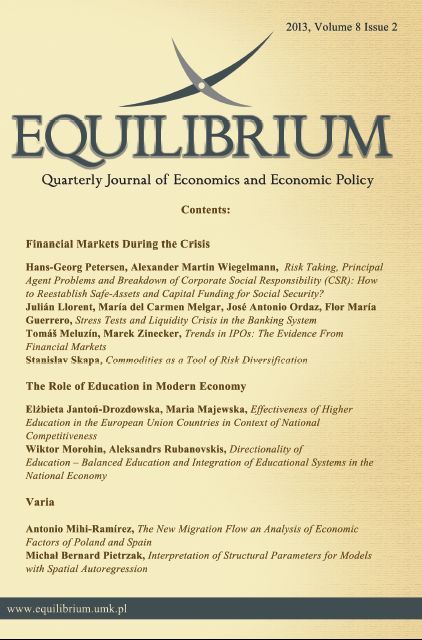The New Migration Flow. An Analysis of Economic Factors of Poland and Spain
DOI:
https://doi.org/10.12775/EQUIL.2013.009Keywords:
international migration, economic migration, migration economic factors, international economicsAbstract
This paper has been focused on the migration flow changes due to the economic factors, comparing differences and similitudes of two European countries with different migration antecedents and circumstances. Thus, Spain has been a traditional host country for economic migrants and Poland has been traditionally considered a sending or transit country, but after the economic collapse these roles have changed and Spain is involved in a severe economic downturn meanwhile Poland has continued to grow economically, therefore it has supposed several changes on the attractiveness of these countries from the perspective of migration. Through the analysis and comparison of international statistics about economic factors for migration this research has examined the evolution, effects and extension of current changes on migration flow of two countries of Europe with different economic situation that is affecting their future migration tendencies. The results have shown that 1) Changes on the economics factors are immediately reflected on the migration flow; 2) the deterioration of these factors in Spain has changed its status as destination country to a country with increasing emigration 3) opposite circumstances have declined the higher migration of Poland, but further investment in Research and Development should be necessary to maintain the economic development.
Downloads
References
Ciarniene R., Kumpikaite K. (2011), International Labour Migration: Students Viewpoint, ?Inzinerine Ekonomika-Engineering Economics?, Vol. 22, No. 5. DOI: http://dx.doi.org/10.5755/j01.ee.22.5.971
De Haas H. (2010), Migration transitions: a Theoretical and empirical inquiry into the developmental drivers of international migration, International Migration Institute, 24, 11th.
European Commission (2012), Eurostat. Economic statistics, http://epp.eurostat.ec. europa.eu/portal/page/portal/eurostat/home.
Fihel A. (2011), Recent trends in international migration in Poland, ?Centre of migration research?, Vol. 52.
Fix M., Papademetriou D., Batalova J., Terrazas A. Yi-Ying Lin, S. Mittelstadt the British Broadcasting Corporation, Washington, DC and London.
García A., Jiménez B., Redondo A. (2009), La inmigración latinoamericana en Espa?a en el siglo XXI, ?Investigaciones Geográficas?, Boletín del Instituto de Geografía, UNAM, Vol. 70.
Heid B., Larch M. (2012), Migration, ?Trade and Unemployment. Economics: The Open-Access, Open-Assessment E-Journal?, Vol. 6, No. 4. DOI: http://dx.doi.org/10.5018/economics-ejournal.ja.2012-4
Iglicka K. (2000), Mechanisms of migration from Poland before and during the transition period, ?Journal of Ethnic and Migration Studies?, Vol. 26, No. 1. DOI: http://dx.doi.org/10.1080/136918300115642
Iglicka K. (2010), EU Membership Highlights Poland's Migration Challenges, ?Migration information source?, September, http://www.migrationinformation.org /Profiles/display.cfm?ID=800
Iglicka K., Weinar A. (2008), Ukrainian migration in Poland from the perspective of Polish policies and systems theory, ?Journal of Immigrant & Refugee Studies?, Vol. 6, No. 3. DOI: http://dx.doi.org/10.1080/15362940802371580
Inotai A. (1998), Correlations between European integration and sub-regional cooperation, ?Russian & East European Finance and Trade?, Vol. 34, No. 6.
Mixon G. (1992), Factors Affecting College Student Migration across States, ?International Journal of Manpower?, Vol. 13, No 1.
Kaczmarczyk P., Okólski M. (2008), Economic impacts of migration on Poland and the Baltic states, Centre of Migration Research University of Warsaw and Fafo.
Kumpikaite V., Zickute I. (2012), Synergy of Migration Theories: Theoretical Insights, ?Inzinerine Ekonomika-Engineering Economics?, Vol. 23, No 4. DOI: http://dx.doi.org/10.5755/j01.ee.23.4.1240
Martín E., Cuberos F., Castellani S. (2012), Latin American immigration to Spain, ?Cultural Studies?, Vol. 26, No. 6. DOI: http://dx.doi.org/10.1080/09502386.2012.669774
OECD (2012), Economic statistics, http://stats.oecd.org/
Papademetriou D.G., Sumption M. (2011), Eight policies to boost the economic contribution of employment-based immigration, Migration Policy Institute http://www.migrationpolicy.org/pubs/competitivenessstrategies-2011.pdf
Piotrowski M., Tong Y. (2010), Economic and non-economic determinants of return migration: Evidence from rural Thailand, ?Population-E?, Vol. 65, No. 2. DOI: http://dx.doi.org/10.3917/pope.1002.0333
Rey A., Cebrán M. (2010), Population replacement and migration in two Spanish regions during the Twentieth century, ?Population-E?, Vol. 5, No 3.
Schierup C., Hansen P., Castles S. (2006), Migration, Citizenship and the European Welfare States. Oxford, Oxford University Press.
Solimano A. (2010), International migration in the age of crisis and globalization: historical and recent experiences, New York: Cambridge University Press.
Stulgien? A., Daunorien? A. (2009), Influence of Migration on Equilibrium of Labour Force Market, ?Economics and Management?, Vol. 14.






